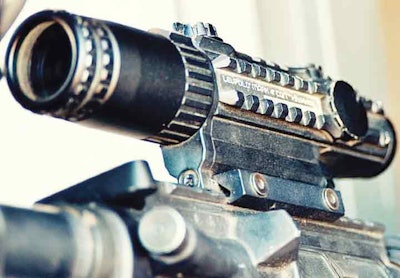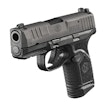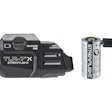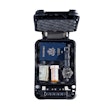 Photo: Mark W. Clark
Photo: Mark W. Clark
The traditional model of law enforcement weaponry has evolved over time through innovation and necessity. Like most significant changes in our line of work, a great portion of it is driven by a "lesson" we learned on the job, the hard way.
From the late 1960s until about 15 years ago American law enforcement officers on patrol were equipped with a pistol. Some had a shotgun as a backup. But rifles and other advanced weaponry were reserved for specialty units and tactical teams. If the situation arose where these special weapons were needed, the call would be made and the special team would respond. No one saw a real need for putting rifles in the hands of the true first responders.
That thinking changed on the morning of Feb. 28, 1997, when two heavily armed men robbed a bank in the North Hollywood district of Los Angeles. Officers confronted the men as they left the bank, and the ensuing gunfight lasted for 44 minutes and ended with numerous officers wounded and the two robbers dead. At the time LAPD patrol officers carried 9mm pistols and 12-gauge shotguns, ineffective against soft body armor and inaccurate at a distance. The assailants were clad with body armor, high on pain killers, and armed with rifles; some of them converted to automatic with high rates of fire. In a nutshell, the LAPD was clearly outgunned.
This incident is forever marked in the history of American policing for several reasons, the most important being the evolution it sparked regarding how we arm our officers on the road. Since that day law enforcement agencies across the country have begun to realize the need for better weapon systems for patrol officers and have developed patrol rifle programs.
A New Standard
Patrol rifle programs are now commonplace, having continued to evolve to better suit the needs of modern law enforcement. Officers aren't just keeping these rifles handy while they wait for the North Hollywood incident to repeat itself. They're doing everything from high-risk stops and crisis entries to clearing buildings on alarm calls with rifles. Today, rifles are almost as relied upon as the standard service pistol.
With the increased use of rifles by patrol officers, there comes the need for modern modifications to make them more effective and to better fit the task at hand. One of the most obvious and likely the most effective is the use of modern optical sighting systems. There are many out there, from cheap to wildly expensive and basic to elaborate. Choosing the right one for the job is essential for getting the most out of the rifle you depend on every day.
Throughout this article I will provide several specific examples of optics available and applicable to patrol rifle use. Please understand that, while I have my personal favorites, I am in no way implying that this is an "all inclusive" list.
The optics discussed are only a small sample of what is available these days and are limited to the ones that I personally have extensive experience with. I would never recommend an optic, or any piece of gear for that matter, unless I had verified its reliability through real-world, hands-on testing. Assume that the application for all of the optics discussed is on an AR-15 variant rifle using a 5.56mm/.223 platform with a 16-inch or shorter barrel, as this configuration is the standard for patrol duty use. I would encourage every officer or agency to conduct their own thorough testing and evaluation process on any optic being considered for duty use.
Optics Vs. Sights
Before we get into the specifics of optics and what I feel are the best options for most patrol deployments, let's first talk about the advantages an optic offers over the traditional iron sights found on most rifles.
Usually iron sights consist of a rear aperture and front sight post, both made of metal and adjusted for windage and elevation for a desired "zero" where the point of aim equals the point of impact. And I would never say they are ineffective or unreliable; in fact, I think they're likely the most reliable option for sighting any weapon system. Many shooters will tell you they actually shoot better with iron sights than they do with optics.
Unfortunately, iron sights have drawbacks. First, aligning two separate objects in order to make an accurate shot takes time. No matter how much practice a shooter has with sights, alignment takes time. Second, the small aperture coupled with the "hard focus" we train for on that front sight post greatly reduces the shooter's field of view. In today's tactical situations, maintaining a wide field of view is critical. Optics generally allow for faster target acquisition and give the users a better sense of the total tactical picture.
CQB Vs. Variable Power
Having established why optics can be valuable for patrol rifles, let's talk about some of the important things to consider when choosing an optic for your rifle or to authorize for department use.
First, if you're choosing optics for your agency, evaluate your audience. Are these rifles and optics going to be issued to every officer and in every car, or is your program something akin to a special assignment where officers need to apply for the assignment and pass a selection and training program? While I would like to think that all officers in our country are properly trained, I do not believe that all of them should have a rifle.
Rifles are more complicated than pistols and their application is unique. More training is required of officers who are allowed to carry rifles in order for them to become operational and remain proficient with this tool. Not all officers are willing or able to take on this responsibility, and we shouldn't force it upon them.
Sophisticated optics such as those with ranging reticles and variable power magnification complicate rifle training. If you are sure the officers deploying with these optics are going to put in the training time necessary to master their features, the benefit can be significant. If not, perhaps iron sights are better.
Next, evaluate your operational considerations. Are you an urban officer or department that will likely utilize rifles in close quarter applications such as those mentioned above? Or are your deployments more likely to be in a perimeter or overwatch position where engagement distances can be significant?
Let's first cover close-quarter applications; those likely to make up the bulk of an urban patrol officer's rifle deployments. In such situations, we discover the need for a simple sighting solution that enables quick target acquisition and maintains a wide field of view. Whether clearing a house or working on a contact team on a crisis call, the close nature of these situations calls for the ability to quickly engage a threat while not losing focus on everything and everyone in the peripheral. A simple optic with a large objective lens, no eye relief, and a simple reticle is essential.
Some examples of close-quarter optics include those from Aimpoint, EOTech, and Trijicon's compact ACOG line. All of these optics provide a true 1X (no magnification) or 1.5X lens with a wide field of view and simple "point and shoot" reticle. This allows the shooter to keep both eyes open and reduce the "tunnel vision" effect while facilitating very fast target acquisition.
Aimpoint and EOTech optics use battery power and project their reticles while the ACOG utilizes an etched reticle that is illuminated by ambient light through fiber optics. All of them are adjustable for various lighting conditions (the ACOG is automatic) and extremely durable. Coincidentally, all three are currently in use by various branches of the U.S. military.
If distance is a primary factor, iron sights can be effective but the range of most rifles will far exceed the ability of a shooter's eye. This is especially true considering the need to identify targets or take a very accurate shot. An optic with the capability of magnification virtually eliminates these limitations and can greatly increase the effective capabilities of that officer. Variable powered optics, when properly paired with a weapon system, can be incredibly valuable tools in the hands of a capable and properly trained patrol officer.
As we stray into the realm of variable power optics, the options are almost endless. The amount of magnification needed, the option of illumination, and the type of reticle are all very important things to consider when looking for variable magnification glass. There is a significant difference between a scope designed for hunting, one made for sniper or designated marksman use, and one designed around a patrol function. My suggestions would be to keep the magnification range to a minimum, keep the reticle simple, and ensure the scope has good illumination.
A few good examples of variable power optics are the Leupold MR/T 1.5–5X, the Bushnell Elite Tactical 1–6.5X, and the Trijicon AccuPoint 1–4X. All of these optics are very durable and designed around a medium- to close-range tactical application. The magnification at their highest setting can assist greatly with target identification and engagement at distance, and at the lowest magnification they can still be used for close- quarter engagements. Essentially, these optics provide the "best of both worlds" and are likely the best option if your needs are varied or your budget only allows one rifle for many applications.
Test and Evaluate
So with so many options out there, how do you choose the right one for your application? Do your homework. Real-world testing, preferably with an example to put through the paces, is the most obvious. Most reputable optics manufacturers will gladly provide a sample for testing, most at no cost.
Manufacturers make optics to make money and their business won't last long without a solid product. Because of this most conduct pretty thorough testing before their optics hit the market, and they provide good company support for any problems or questions you may have. If you want to know how loyal a company is to its product, just look at the warranty. Some of the best include a lifetime warranty where, aside from running over your optic with a tank, they'll repair or replace it at no cost to you. Remember, the money you pay for an optic isn't only for the initial product, but for the support and peace of mind you'll have for that investment 10 years down the road. The price tag shouldn't be anywhere near the top of your priority list.
I would also encourage researching the testing other agencies and end-users have done on that particular optic. The military is likely the most thorough when it comes to testing optics, or any piece of gear for that matter. Their motivation is simple; if the military gives it to their troops, failure isn't an option. The U.S. government has an almost unlimited budget for this testing process and if you've ever reviewed their findings you know "thorough" doesn't begin to describe their methods. If an optic has earned a military specification number, you can be pretty sure it is a solid piece of equipment.
If your agency is like mine, you have neighboring agencies and jurisdictions you work with daily. A simple phone call to their firearms staff can provide a lot of good information.
I am fortunate to work in a large metropolitan area with many different agencies to collaborate with. Every year we make a point to get together for a few days of training and sharing of ideas. You'd be amazed how much can be learned from only a few days of talking to your peers. If you or your agency doesn't normally do something like this I would strongly suggest you start. On more than one occasion I have considered a piece of gear or tactic only to find out another agency has already found it to be unreliable or ineffective.
Most importantly, once you've weeded through all of the research and testing and decided on an optic that is right for you or your agency, you must dedicate the time and training necessary to utilize this tool properly. The best equipped, most advanced, and insanely expensive weapon system in the world is worthless in the hands of an untrained operator.
Read the manuals and know the optic's features front to back. Get out on the range and train as much as you can. The new reticle that took the place of your iron sights should be comfortable and familiar every time it meets your eyes. And if the day comes when you do have to pull the trigger and take that critical shot, there shouldn't be an ounce of doubt in your mind that the optic you chose was the right choice.
A.J. George is a police officer and firearms instructor in Scottsdale, Ariz.
For More Information:
Related:
Police Product Test: Bushnell DMR 3.5-21x50, SMRS 1-6.5x24 Optics














